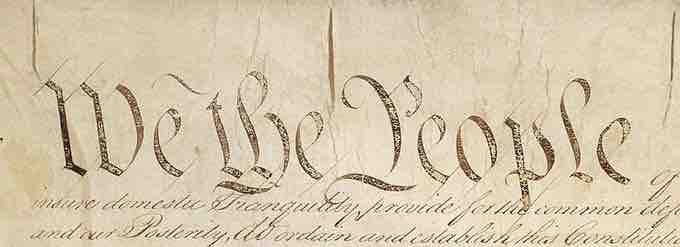Introduction
A constitutionally limited government is a system of government that is bound to certain principles of action by a state constitution. This system of government is dialectically opposed to pragmatism, on the basis that no state action can be made that conflicts with its constitution, regardless of the action's possible consequences. An example of a constitutionally limited government is the United States of America, which is a constitutionally limited republic. Correspondingly, constitutionalism has a variety of meanings. Most generally, it is "a complex of ideas, attitudes, and patterns of behavior elaborating the principle that the authority of government derives from and is limited by a body of fundamental law." In the United States Constitution , several articles and sections describe and specify the limits set upon the federal and state governments in the Union.

United States Constitution
"We the People", as it appears in an original copy of the Constitution.
Legislature
Article I, Section 9 lists eight specific limits on congressional power. It includes sections such as "No Capitation, or other direct, Tax shall be laid, unless in Proportion to the Census or Enumeration herein before directed to be taken" and "No Title of Nobility shall be granted by the United States: And no Person holding any Office of Profit or Trust under them, shall, without the Consent of the Congress, accept of any present, Emolument, Office, or Title, of any kind whatever, from any King, Prince, or foreign State. "
Executive
Article II, Section 1 creates the presidency. The section vests the executive power in a President. The President and Vice President serve identical four-year terms. This section originally set the method of electing the President and Vice President, but this method has been superseded by the Twelfth Amendment. More importantly, Section 2 grants and limits the president's appointment powers: "The president may make treaties, with the advice and consent of the Senate, provided two-thirds of the senators who are present agree;" "With the advice and consent of the Senate, the President may appoint ambassadors, other public ministers and consuls, judges of the Supreme Court, and all other officers of the United States whose appointments are not otherwise described in the Constitution;" and "Congress may give the power to appoint lower officers to the President alone, to the courts, or to the heads of departments. " In addition, the Twenty-fifth Amendment limits the presidency to two terms .
Twenty-Fifth Amendment
Joint Resolution Proposing the Twenty-fifth Amendment to the United States Constitution, page 1.
Self Restraint
The Supreme Court has developed a system of doctrine and practice that self-limits is power of judicial review. The Court controls almost all of its business by choosing what cases to consider, writs of certiorari. In this way it can avoid expressing an opinion if it sees an issue is currently embarrassing or difficult. The Supreme Court limits itself by defining for itself what is a "justiciable question. " First, the Court is fairly consistent in refusing to make any "advisory opinions" in advance of actual cases. Second, "friendly suits" between those of the same legal interest are not considered. Third, the Court requires a "personal interest," not one generally held, and a legally protected right must be immediately threatened by government action. Cases are not taken up if the litigant has no standing to sue. Having the money to sue or being injured by government action alone are not enough.
Codified and Uncodified Constitutions
A constitution is a set of fundamental principles or established precedents according to which a state or other organization is governed. These rules together make up, i.e. constitute, what the entity is. When these principles are written down into a single document or set of legal documents, those documents may be said to embody a written constitution; if they are written down in a single comprehensive document, it is said to embody a codified constitution.
Codified constitutions are often the product of some dramatic political change, such as a revolution. States that have codified constitutions normally give the constitution supremacy over ordinary statute law. Some constitutions are largely, but not wholly, codified. As of 2013, only two sovereign states have uncodified constitutions, namely New Zealand and the United Kingdom. Uncodified constitutions are the product of an "evolution" of laws and conventions over centuries. By contrast to codified constitutions (in the Westminster System that originated in England), uncodified constitutions include written sources.